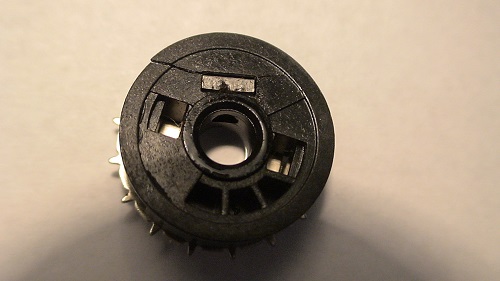|
Author
|
Topic: Eumig 807D Question
|
|
|
|
|
Paul Adsett
Film God
Posts: 5003
From: USA
Registered: Jun 2003
|
 posted October 03, 2015 01:05 PM
posted October 03, 2015 01:05 PM



Steve, the cracking problem is solely associated with the stress induced by the tightening of the grub screw. In use, the only running stress on the plastic hub is the tension induced by the roll off of film from the supply reel, which is negligible. The tapping of the grub screw thread in the plastic hub results in a stress concentration around the tapped hole, which produces a crack when the screw is tightened, which gradually gets larger until the whole part fails (sounds like the Dehavilland Comet disaster doesn't it, and its the same kind of thing, resulting from what was probably zero stress analysis by the Eumig engineers). A lot of the small plastic parts on Eumig's seem prone to cracking, which leaves you wondering that some people in their design team thought that designing parts in plastic was no different than designing the same part in metal.
so, if this part were to be remade in plastic it should include helicoil inserts in the plastic thread to help distribute the stress in that area, plus a filled type of plastic such as Delrin AF might be more suitable material. Bottom line though, the part should probably have been metal.
--------------------
The best of all worlds- 8mm, super 8mm, 9.5mm, and HD Digital Projection,
Elmo GS1200 f1.0 2-blade
Eumig S938 Stereo f1.0 Ektar
Panasonic PT-AE4000U digital pj
| IP: Logged
|
|
|
|
|
|
|
|
Paul Adsett
Film God
Posts: 5003
From: USA
Registered: Jun 2003
|
 posted October 05, 2015 09:42 AM
posted October 05, 2015 09:42 AM



I had forgotten about the nut! So I took the sprocket off my 824D to get some picks, and low and behold the plastic is cracked on this one too! So this failure must be very common.
Anyway, Steve's observation is quite correct, the plastic itself is not threaded, and when you tighten the set screw it pulls outward on the nut plate as you tighten the screw against the shaft, This puts a very high tensile stress right at the outer corner of the rectangular slot in the plastic hub, where there is already a stress concentration by virtue of that sharp corner. You can see from the photo exactly how the crack would propagate outward from the corner.

To Frank's point about the load induced upon reverse projection. Yes this would obviously be much greater than during forward running when the feed spool is not being driven. But this load would be a torque load on the sprocket which would not put anywhere near the load on the plastic hub compared with the load induced by tightening the set screw. Remember that threads have huge mechanical advantage. I think the failure mode of the radial crack propagating from the slot pretty well nails the root cause.
If Eumig had rounded the corners i.e. like an oval with a full radius at each end of the slot, then the stress concentration would have been much less, and then maybe the part would not have cracked. (This is sounding more like the Comet disaster every day- rememeber that the square windows on the original Comet resulted in a very high stress concentration in the fuselage and ultimate cracking and explosive decompression)
--------------------
The best of all worlds- 8mm, super 8mm, 9.5mm, and HD Digital Projection,
Elmo GS1200 f1.0 2-blade
Eumig S938 Stereo f1.0 Ektar
Panasonic PT-AE4000U digital pj
| IP: Logged
|
|
|
|
|



 UBBFriend: Email this page to someone!
UBBFriend: Email this page to someone!
 Printer-friendly view of this topic
Printer-friendly view of this topic




![[Wink]](wink.gif)

![[Smile]](smile.gif)



